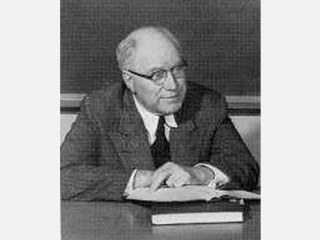
Alvin Hansen biography
Date of birth : 1887-08-23
Date of death : 1975-06-06
Birthplace : Viborg, South Dakota
Nationality : American
Category : Famous Figures
Last modified : 2010-11-25
Credited as : Economist, ,
The influential economist Alvin Hansen brought the 1930's Keynesian revolution in economics to the United States. He was a prolific writer who also played significant roles in the creation of the Social Security System and the Council of Economic Advisors.
Alvin Hansen was born at Viborg, South Dakota, on Aug. 23, 1887, to Danish parents. He graduated from Yankton College in South Dakota in 1910 and worked several years as a high school teacher, then principal, then county school superintendent, before returning to school for graduate studies, which he completed at the University of Wisconsin in 1918. He taught at Brown University until his appointment at the University of Minnesota in 1923. His major works in this period on business cycles and economic stabilization were in the neoclassical economics tradition.
In 1937 he accepted a prestigious appointment as Lucius N. Littauer Professor of Political Economy at Harvard University. Hansen's seminar on fiscal policy created a generation of graduate students, such as Paul Samuelson and James Tobin, who supported Keynesian economics. His 1938 book Full Recovery or Stagnation? was based on but a few paragraphs of Keynes's The General Theory of Employment, but it was an extended argument that employment stagnation would continue for decades to come. Ultimately, stagnation theories became more associated with Hansen, rather than Keynes. His 1941 book on fiscal policy and business cycles was the first major work in the United States to entirely support Keynes's analysis of the causes of the Great Depression, and he used that analysis to support Keynes's mainstay of deficit spending.
Hansen was much more than just a disciple of Keynes. He found serious mistakes in Keynes's presentation; he implemented Keynes, for example, by developing tax and spending models which clarified tax and spending policies as weapons in Keynes's arsenal, and he criticized Keynes for putting too much faith in interest rates and monetary policy. Still, one of his most influential teaching devices was his book, A Guide to Keynes, which took students through Keynes's General Theory chapter by chapter and, at times, paragraph by paragraph.
Hansen's teaching, in essence, was that government should not put the main burden of inflation control on unemployment by its inaction. He thought inflation control should be exercised by timely changes in tax rates, by appropriate changes in the money supply, and by effective wage-price controls. He was said to be "a sparkling teacher." He wrote fifteen books, including an account of the Bretton Woods Conference that helped to establish the World Bank. His books were widely translated and read world-wide.
During the Roosevelt and Truman years, Hansen was of considerable influence in shaping fiscal policies as a member of numerous government commissions and as consultant to the Federal Reserve Board, the Treasury Department and the National Resources Planning Board. In 1935, he helped create the Social Security System and in 1946, he helped in the drafting of the Full Employment Act which among other things created the Council of Economic Advisors. Hansen also served as Vice President of the American Statistical Association and President of the American Economics Association.
After retiring from Harvard University in 1957, Hansen taught at the University of Bombay and at numerous American universities almost to his death in 1975.
Robert Lekachman, The Age of Keynes (1966), has a long and interesting analysis of the influence of Hansen on the development of Keynesian thought in America; Joseph Dorfman, The Economic Mind in American Civilization, vol. 5 (1959), focuses on Hansen's early career; Ben B. Seligman, Main Currents in Modern Economics: Economic Thought since 1870 (1962), discusses Hansen's entire career; For more recent works about Hansen, see the article by some of his former students in Quarterly Journal of Economics, Feburary, 1976; and W. Breit and R.L. Ransom, The Academic Scribblers: American Economists in Collision (1982).
















